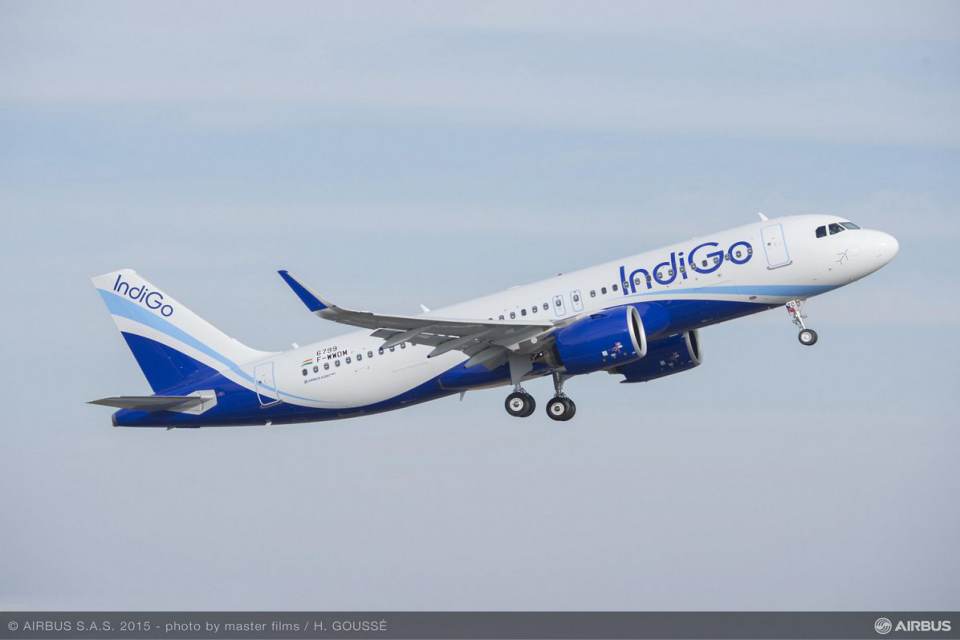Airlines
Indigo’s flight reports engine stalls warning mid-air as big jet creates ‘wake-turbulence’
Indigo’s flight reports engine stalls warning mid-air as Boeing 777 creates ‘wake-turbulence’

An Airbus A320 operated by IndiGo experienced an uncommon occurrence on Monday while passing over the Guwahati to Mumbai route at a height of about 36,000 feet. The captain detected an Engine 1 stall warning signal that suddenly disappeared. Due to a larger jet of a Boeing 777 aircraft traveling in the opposite way of Indigo’s A320 aircraft, which generates “Wake Turbulence” mid-air, IndiGo flight 6E-6812 briefly had an engine 1 stall warning signal, an official told ANI.
The IndiGo plane was traveling well to its destination after seeing wake turbulence from an Emirates Boeing (B-777) large airliner. At roughly 6:32 am, an IndiGo flight with a destination of Mumbai departed from Guwahati airport on time. The huge jet aircraft that crossed in the opposite direction of the Indigo aircraft caused the “wake turbulence,” which is termed.
Four myths about air turbulence. How Dangerous Is It?(Opens in a new browser tab)
The major US-based transportation regulator, the Federation Aviation Administration (FAA), explicitly states that wake turbulence can occasionally be insignificant or catastrophic.
The weight, wingspan, size, and proximity to the original aircraft, as well as the point of the vortex collision, determine the impact of the encounter.
Wake turbulence can impose rolling moments that are greater than the roll-control authority of approaching aircraft, thereby endangering the safety of the passengers and damaging the aircraft. When passing through another aircraft’s wake, pilots should always be alert for the risk of encountering wake turbulence and change their flight route appropriately.
There was no harm done to the plane or the passengers, and the airline’s company reported the occurrence to India’s aviation oversight agency, Director General Civil Aviation (DGCA).

Airlines
Air India Rolls Out A350s for Delhi-New York JFK and Newark Routes

In a major development for North American travelers, Air India has announced the deployment of its state-of-the-art Airbus A350-900 aircraft on two key routes: Delhi to New York and Delhi to Newark.
The service on the Delhi-New York route will commence on November 1, 2024, while the Delhi-Newark route will see its inaugural flight on January 2, 2025.
The introduction of the air india a350 will bring significant enhancements to Air India’s offerings, particularly with the launch of its Premium Economy class. air india retrofit This new class will feature 24 wide seats arranged in a 2-4-2 configuration, providing passengers with extra legroom and a more comfortable flying experience.
Soon, Air India aircraft will feature onboard WiFi & all-new cabins: Click here
“We are encouraged by the positive guest feedback we have received from the domestic deployment of our air india a350 interior to offer our hero product on the Delhi-New York JFK and Delhi-Newark routes. This is a significant leap forward for our U.S. operations that also underscores our commitment to continuous improvement,” said Campbell Wilson, Chief Executive Officer & Managing Director of Air India.
The A350’s Business class will set new standards with 28 private suites, each equipped with full-flat beds, direct aisle access, and personal wardrobes. Economy class will be configured to accommodate 264 passengers in a 3-4-3 layout. Across all cabins, passengers will enjoy the latest Panasonic eX3 in-flight entertainment system, offering over 2,200 hours of content.
Air India’s First A350-900: Interior, Routes, &Inflight Features: Click here
This strategic deployment marks a notable enhancement in Air India’s U.S. operations, with 60% of its flights to the U.S. now featuring new or upgraded cabin interiors. The air india new international routes currently operates 51 weekly flights to five U.S. destinations: New York JFK, Newark, Washington DC, Chicago, and San Francisco.
The revamped cabins, advanced in-flight entertainment systems, and improved service standards represent air india wifi commitment to providing a superior travel experience. “We believe this enhanced offering will solidify Air India’s position as a leading carrier and attract travellers seeking a world-class flying experience between India and the United States,” the airline stated.
Seats on these flights are now available for booking on Air India’s website, mobile app, and through travel agents, ensuring that passengers can easily plan their journeys on these newly upgraded routes.
Air India Economy vs Qatar airways economy: which is best?:Click here
-

 Travel1 week ago
Travel1 week agoAir India to Expand US Operations with Three New Routes After a Decade
-

 Travel2 weeks ago
Travel2 weeks agoWhy We Should Avoid These Stamps in a Passport
-

 Airlines1 month ago
Airlines1 month agoInvestigations Reveal Fake Chinese Titanium in Boeing and Airbus Jets
-

 Tech4 weeks ago
Tech4 weeks agoChina’s CATL Plans 1,800-Mile Electric Plane Launch by 2027
-

 Airport3 days ago
Airport3 days agoTop 10 Largest Airports in the World by Size
-

 Aerospace4 weeks ago
Aerospace4 weeks agoChina’s Fighter Jets Turn Wings into Autonomous Drones
-

 Airlines4 days ago
Airlines4 days agoAir India Rolls Out A350s for Delhi-New York JFK and Newark Routes
-

 Defence3 weeks ago
Defence3 weeks agoBoeing Enhances Chinook with New Engines and Block II Upgrades at $96 Million







